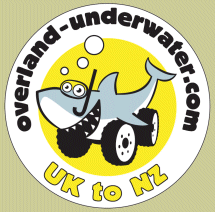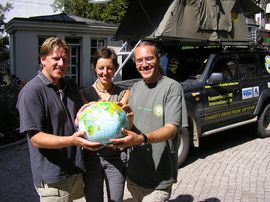| Final Statistics: Alex & Maz | Total distance: 93,550km |
| Furthest Point: Rotorua, NZ | Now settled in Sydney, Australia |
| Final Statistics: Martin | Total distance: 79,698km |
| Furthest Point: Hobart, Australia | Now settled in Bristol, UK |
Summer Turns to Winter As Lead Car Crosses Equator
Indonesia, Country 24, Diary entry 22nd July-3rd August 2006, Total distance in Indonesia: 6750km (estimated)
My last morning in Singapore saw me up early to make my way to the harbour to catch the boat out of Singapore to Batam, a little island only about an hour boat ride away but belonging to Indonesia. Insight Marine were still looking after me and I met Luthfi and his wife at the harbour. They had my boat ticket for me and accompanied me on the boat to Batam and once on Batam to the airport as they were flying to Jakarta. It is much cheaper that way than flying direct from Singapore. I was presented with my ticket for Sriwajaya Airlines' (whose?!) flight to Medan. Well I say "my ticket" but it was actually the ticket for a Mr. Titwoot, but since nobody checked any ID at any point, nobody noticed an impostor taking his place. I managed to get some sleep on the flight and landed an hour and a half later. I felt slightly disappointed with myself for taking an aeroplane as I had got this considerable distance from home without using one, but from East Timor to Darwin I'll have no choice anyway so I soon got over it.
 I found Medan interesting for all the wrong reasons. I hadn't really realised it, but this type of city was missing from my list of experience so far: a poor, busy, large Southeast Asian city. I had seen poor and busy in India and other countries, but the flavour is different in Southeast Asia. All the big cities in Thailand and Malaysia have a feel of money to them with their clean smooth roads and shiny buildings, and even the capitals of their neighbours Vientiane and Phnom Penh are not so busy and show signs of much foreign investment. Medan was dusty, noisy and badly polluted, the buildings looked like it was by sheer willpower that they were still standing, and it sprawled for miles in every direction. I was stuck there for at least a couple of days until the ship arrived with my Land Cruiser on it so I did make the attempt to go exploring and my quest was rewarded with a shopping mall which was blissfully air-conditioned and had a Starbucks. So now I know they have them in Indonesia too, and it made a pleasant change of scenery from the inside of my cheap hotel room. The mall was mostly girls' clothes shops (as anywhere else in the world I suppose) but on the top floor I found a DVD shop with the latest releases at about 60p each so I bought a few to keep me entertained between internet sessions until the car arrived.
I found Medan interesting for all the wrong reasons. I hadn't really realised it, but this type of city was missing from my list of experience so far: a poor, busy, large Southeast Asian city. I had seen poor and busy in India and other countries, but the flavour is different in Southeast Asia. All the big cities in Thailand and Malaysia have a feel of money to them with their clean smooth roads and shiny buildings, and even the capitals of their neighbours Vientiane and Phnom Penh are not so busy and show signs of much foreign investment. Medan was dusty, noisy and badly polluted, the buildings looked like it was by sheer willpower that they were still standing, and it sprawled for miles in every direction. I was stuck there for at least a couple of days until the ship arrived with my Land Cruiser on it so I did make the attempt to go exploring and my quest was rewarded with a shopping mall which was blissfully air-conditioned and had a Starbucks. So now I know they have them in Indonesia too, and it made a pleasant change of scenery from the inside of my cheap hotel room. The mall was mostly girls' clothes shops (as anywhere else in the world I suppose) but on the top floor I found a DVD shop with the latest releases at about 60p each so I bought a few to keep me entertained between internet sessions until the car arrived.
Expecting the ship to arrive on the Tuesday, I checked my email on the Monday at about 2pm and there was a message from Captain Baharudin informing me that the ship's ETA at Belawan (15km away) was midday that day! So there followed some frantic SMS messages back and forth asking the simple question - "how do I get my car then?" - and I was given the name Mr Bambang and a telephone number. I'm not quite sure who Mr Bambang was, but he was incredibly helpful - firstly we found the ship and some of the crew put two and two together and realised that the foreign-looking bloke was there for the foreign-looking car and waved us off in the direction of a warehouse where they'd moved it safely out of the way. There she was, in the same condition as when I'd last seen her in Singapore. I never did see how they loaded her and lashed her to the deck but maybe that's for the best. (I subsequently received photos from James at Insight who supervised the loading, see my previous diary entry).
First stop customs, which everyone I'd asked had assumed would be a total nightmare - the people at Insight and their contacts in the shipping industry were worried about the paperwork - but it was as simple as the smoothest border crossing. The guy knew what the carnet was, stamped stamped and I think stamped again and handed it back ready to go! Things were going well! Too well, in fact, because the next hurdle of clearing the Belawan port admin charges was rather more complicated. Unfortunately it being all of about 3:40pm by this time, they'd buggered off home for the day but after imploring Mr. Bambang that I needed my car that day, he made some phone calls and arranged that we could go to the agent's office in the centre of Medan where they would keep the office open for us. Although it's only 15km the traffic is so dire that it took nearly an hour each way, so on the way back we had to make more phone calls to make sure they wouldn't lock my car away for the night before we got back! We made it though - another rather steep charge for stevedoring and storage followed at the warehouse (nearly 100 quid) but then my car was free and I could drive out of the docks and after profuse thanks to Mr. Bambang for all his help, I started heading back to the centre of Medan and the hotel. I spent the evening rotating the tyres and checking the brake pads ready for the bad Sumatran roads - a job I'd planned for Singapore but put off because of my stomach infection.
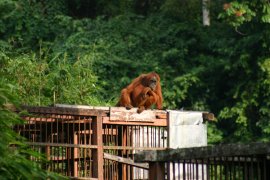 The first sight I'd planned for Sumatra was a half-day drive to the edges of the Gunung Leuser National Park where the famous Bohorok Orangutan Rehabilitation Centre is located.
The first sight I'd planned for Sumatra was a half-day drive to the edges of the Gunung Leuser National Park where the famous Bohorok Orangutan Rehabilitation Centre is located.
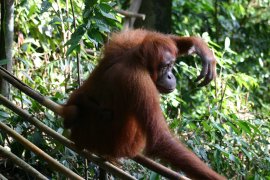 The Gunung Leuser National Park is one of the world's last remaining orangutan strongholds with more than 5000 animals thought to be living in the wild. The Bohorok centre tries to rehabilitate orangutans back into the wild after a period of captivity. Most of the orangutans that have been through the system were kept as pets by affluent Indonesians or Malays, and keeping of orangutans has since been banned so some were voluntarily given up and others confiscated. The centre will keep them in quarantine for a period of time - orangutans are physiologically so similar to humans that they can contract human diseases and if released into the wild an epidemic could result - and at the same time they relearn basic skills such as climbing trees and moving around by swinging as is their way in the wild, whereas in captivity they move around on the ground.
The Gunung Leuser National Park is one of the world's last remaining orangutan strongholds with more than 5000 animals thought to be living in the wild. The Bohorok centre tries to rehabilitate orangutans back into the wild after a period of captivity. Most of the orangutans that have been through the system were kept as pets by affluent Indonesians or Malays, and keeping of orangutans has since been banned so some were voluntarily given up and others confiscated. The centre will keep them in quarantine for a period of time - orangutans are physiologically so similar to humans that they can contract human diseases and if released into the wild an epidemic could result - and at the same time they relearn basic skills such as climbing trees and moving around by swinging as is their way in the wild, whereas in captivity they move around on the ground. 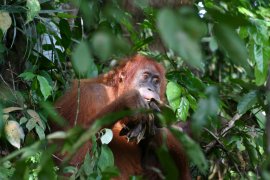 In the wild this would make them too easy a prey for their predators. When they are ready they are released into the wild but there is a place where they can access twice-daily feeding sessions of milk and bananas. The idea is that a monotonous diet will encourage the orangutans to look for their own food and become self-sufficient, but an added bonus of the feeding sessions is that tourists can come to watch at a designated viewing area which brings essential income to fund the centre's work.
In the wild this would make them too easy a prey for their predators. When they are ready they are released into the wild but there is a place where they can access twice-daily feeding sessions of milk and bananas. The idea is that a monotonous diet will encourage the orangutans to look for their own food and become self-sufficient, but an added bonus of the feeding sessions is that tourists can come to watch at a designated viewing area which brings essential income to fund the centre's work.
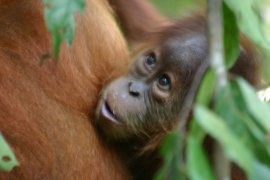 I arrived in the middle of the afternoon and found a place to stay before joining the late afternoon's feeding session. To get to the viewing area means crossing the river in a very unsteady canoe tied to an overhead line, and in the open area on the other side are a series of cages, of which two were occupied by orangutans still undergoing the rehabilitation process, though sadly these two had been in the process for some time and were unlikely to ever be deemed fit to survive in the wild. Big, orange and hairy, as you'd expect, but being caged it was no different to seeing bored animals in the zoo. Not what I'd come all this way for, so we continued up to the feeding area.
I arrived in the middle of the afternoon and found a place to stay before joining the late afternoon's feeding session. To get to the viewing area means crossing the river in a very unsteady canoe tied to an overhead line, and in the open area on the other side are a series of cages, of which two were occupied by orangutans still undergoing the rehabilitation process, though sadly these two had been in the process for some time and were unlikely to ever be deemed fit to survive in the wild. Big, orange and hairy, as you'd expect, but being caged it was no different to seeing bored animals in the zoo. Not what I'd come all this way for, so we continued up to the feeding area.
Unfortunately at this time of year there is an abundance of forest food and the orangutans obviously decided that milk and bananas was too boring for them. None arrived, but we were entertained by a band of macaques who decided that free bananas were good enough for them... when they weren't busy copulating at least.
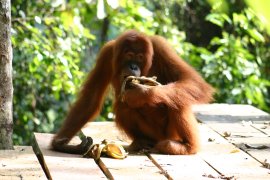 The next morning was a lot more successful, and it seems the morning session must obviously be more successful generally as there were probably about 25 of us this time, compared to 5 the previous afternoon. On crossing the river there was a large orangutan sitting on top of one of the two occupied cages - he was obviously paying a social visit which we interrupted as he got up and stretched out his hugely long arms as if saying "I really must be going now" and disappeared up a tree. My first wild orangutan!
The next morning was a lot more successful, and it seems the morning session must obviously be more successful generally as there were probably about 25 of us this time, compared to 5 the previous afternoon. On crossing the river there was a large orangutan sitting on top of one of the two occupied cages - he was obviously paying a social visit which we interrupted as he got up and stretched out his hugely long arms as if saying "I really must be going now" and disappeared up a tree. My first wild orangutan!
Rather than keeping us waiting, it seemed we were the ones keeping them waiting as there were already three orangutans at the feeding station waiting for their breakfast to arrive. The rangers threw bananas to them which they ate sloppily, and more arrived swinging with grace and agility through the trees. They stayed with us for about half an hour and seemed totally unperturbed by our presence and a mother and baby even ambled through the middle of the group (I guess they're used to it). Once all the bananas were gone they disappeared again as quickly as they'd arrived, once again bending the saplings with their weight to move from one to the next, and it was time for us to go too.
It was still early morning and I was keen to get some of the huge number of kilometres under my belt. One of the things I did while waiting for the car in Medan was to calculate a schedule for Indonesia, working out how long it'd take to get around and then what was realistic to achieve in the short time available to me. I was a bit shocked by the result - of course I want to see the main sights (orangutans already done, volcanic scenery, the major temples, big lizards and hopefully some diving) but even with these things not being too far off the main roads, I calculated I need pretty much all of the 60 days my visa allows! The main problem is the condition of the roads. I'd already worked out I'd be doing something like 6000 or 7000km but the traffic and condition of the roads mean that an average of 40-50km/h is realistic - you can work out the number of driving hours that means. It had taken three and a half hours to get to Bukit Lawang, a mere 100km, and though I was expecting the roads to improve I still had to return pretty much all the way to Medan to start heading south. As a result during my time in the north of Sumatra I was a bit itchy to get some kilometres completed and not hang around too much.
The drive to Lake Toba was not nearly so bad once I'd passed Medan. The roads were narrow and with occasional large potholes requiring a heavy foot on the brake pedal but not nearly as bone-jarring as the road to Bukit Lawang. I arrived on the north side of the lake and could see the blue water and rising from it the island of Samosir. Lake Toba was to be the first of several volcanic craters with a lake inside and a new volcanic cone rising from it during my time in Indonesia, and it was a spectacular one to start with. Samosir Island is almost as large as Singapore.
 I drove round to the west side of the island and descended a long road with hairpin bends to the bottom of the crater stopping along the way several times to take in the beautiful views. From there I crossed a narrow isthmus to Samosir Island and drove round to the eastern side of the island where the guesthouses are. It was dark when I arrived.
I drove round to the west side of the island and descended a long road with hairpin bends to the bottom of the crater stopping along the way several times to take in the beautiful views. From there I crossed a narrow isthmus to Samosir Island and drove round to the eastern side of the island where the guesthouses are. It was dark when I arrived.
One thing that struck me as unusual was that as I approached Lake Toba the mosques disappeared and were replaced by churches! I had always assumed Indonesia to be a Muslim country so I made a quick consultation of the guide to all things, also known as the Lonely Planet, which revealed that this area is populated by the Batak tribe. The Bataks were originally animist and ancestor-worshippers and had long been squeezed between the Islamic strongholds of Aceh and West Sumatra whose activists tried to convert the Bataks, but finally it was through the Dutch and their missionaries that the word of Protestant Christianity became widespread throughout this region - to an extent at least. Though Protestantism is the dominant religion there are still some of the old animist traditions which survive to this day.
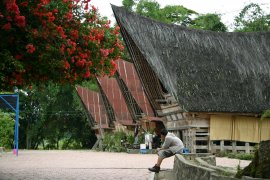 I stayed the night at Tabo Cottages, a beautifully constructed resort with stunning lake views starting at about 2 quid per night and though they were arranging a boat trip and waterfall visit for the next day, I consulted the schedule and decided I'd rather push southwards a bit further before relaxing too much.
I stayed the night at Tabo Cottages, a beautifully constructed resort with stunning lake views starting at about 2 quid per night and though they were arranging a boat trip and waterfall visit for the next day, I consulted the schedule and decided I'd rather push southwards a bit further before relaxing too much.
I didn't want to bypass anything despite the urge to get on the road, so I decided on the 1pm ferry from Samosir Island back to the mainland to avoid the long winding road I'd come in on, and so I could force myself to spend the morning seeing the sights of the island. In the end I only looked at Tomok which is where the ferry goes from, but is interesting for Batak culture.
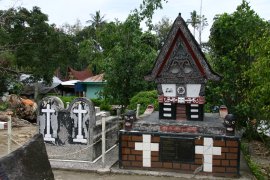 The most distinctive element of Batak culture is the typical architecture. Batak houses are built on stilts with a saddleback shaped roof extending to fine points front and rear and often intricately decorated on the walls with carvings in the wood and masks. In Tomok it's also possible to visit some Batak graves which are interestingly decorated in a mixture of Batak and Christian styles.
The most distinctive element of Batak culture is the typical architecture. Batak houses are built on stilts with a saddleback shaped roof extending to fine points front and rear and often intricately decorated on the walls with carvings in the wood and masks. In Tomok it's also possible to visit some Batak graves which are interestingly decorated in a mixture of Batak and Christian styles.
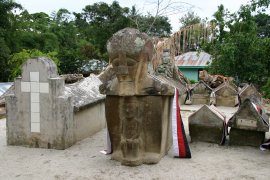 So then it was time to catch the ferry which crawled across the lake at a snail's pace and finally I could drive off and start doing some of those kilometres I was so keen to do. The road is Route 25, also known as the Trans-Sumatran Highway, which is a bit of optimism on the part of the person who named it, as it is a single carriageway road, most of the time but not always wide enough for two vehicles to pass (if the oncoming vehicle moves to its side of the road, that is),
So then it was time to catch the ferry which crawled across the lake at a snail's pace and finally I could drive off and start doing some of those kilometres I was so keen to do. The road is Route 25, also known as the Trans-Sumatran Highway, which is a bit of optimism on the part of the person who named it, as it is a single carriageway road, most of the time but not always wide enough for two vehicles to pass (if the oncoming vehicle moves to its side of the road, that is), 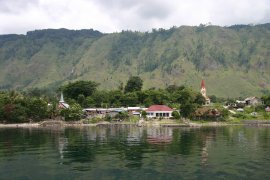 and in places potholed or even totally unsurfaced. It took me back to the bad old days of Indian roads and the hope that things improve from here, but to be honest I doubt they will get any better on Sumatra, maybe not even on Java. Fingers crossed anyway. I drove for about five hours and in that time saw not one single spot where it would have been OK for camping - every single scrap of level ground had crops growing on it and again like India, there are people EVERYWHERE so when I saw a hotel in the small town of Padangsidempuan I elected to stop there for the night.
and in places potholed or even totally unsurfaced. It took me back to the bad old days of Indian roads and the hope that things improve from here, but to be honest I doubt they will get any better on Sumatra, maybe not even on Java. Fingers crossed anyway. I drove for about five hours and in that time saw not one single spot where it would have been OK for camping - every single scrap of level ground had crops growing on it and again like India, there are people EVERYWHERE so when I saw a hotel in the small town of Padangsidempuan I elected to stop there for the night.
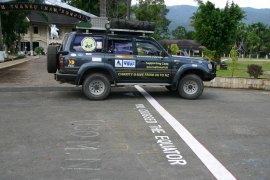 It was another long day driving the next day to Bukittinggi, the highlight of the day being THE EQUATOR! Finally, after nearly a year of driving I crossed the line between northern and southern hemisphere. The road crosses in a place called Bonjol and they have made the most of the sales opportunity with a variety of markers including a big overhead gantry, plus also statues and globes. There is also a museum, but I didn't stop as the admission fee was frankly rather ambitious and I was getting pretty annoyed with all the equator souvenir T-shirt vendors who were starting to mob the car.
It was another long day driving the next day to Bukittinggi, the highlight of the day being THE EQUATOR! Finally, after nearly a year of driving I crossed the line between northern and southern hemisphere. The road crosses in a place called Bonjol and they have made the most of the sales opportunity with a variety of markers including a big overhead gantry, plus also statues and globes. There is also a museum, but I didn't stop as the admission fee was frankly rather ambitious and I was getting pretty annoyed with all the equator souvenir T-shirt vendors who were starting to mob the car.
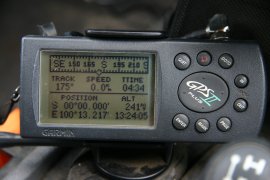 Bukittinggi is supposed to be a nice pleasant tourist town but on arrival it was absolutely dumping down with rain, a common Sumatran theme starting here, giving the place a dismal feel. It was actually quite cold too, because of the altitude (bukit = hill, tinggi = high or tall) or perhaps because now I was of course in the middle of winter :) but either way I once again decided it was not camping weather, and it would have been pretty hard to find somewhere anyway, so I checked into a budget hotel. I opened the tailgate and it opened upwards and to the left instead of straight upwards - scissor doors are good on a Lamborghini but not good at all on a Land Cruiser!
Bukittinggi is supposed to be a nice pleasant tourist town but on arrival it was absolutely dumping down with rain, a common Sumatran theme starting here, giving the place a dismal feel. It was actually quite cold too, because of the altitude (bukit = hill, tinggi = high or tall) or perhaps because now I was of course in the middle of winter :) but either way I once again decided it was not camping weather, and it would have been pretty hard to find somewhere anyway, so I checked into a budget hotel. I opened the tailgate and it opened upwards and to the left instead of straight upwards - scissor doors are good on a Lamborghini but not good at all on a Land Cruiser! 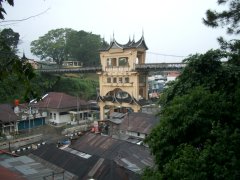 It transpired that one of the hinges had completely snapped! Well, nothing could be done that late in the afternoon so I got everything out that I thought I would need for the night and closed up again, then wandered round the town for a bit. There's nothing to see except the remains of an old Dutch fort, and in keeping with the others I'd seen (notably on Pangkor Island in Malaysia) it'd pretty much crumbled away. Those Dutch need to learn some things about fort building as they seem to have been pretty rubbish at it. It was actually getting cold (!) so returned to the hotel and retired to bed.
It transpired that one of the hinges had completely snapped! Well, nothing could be done that late in the afternoon so I got everything out that I thought I would need for the night and closed up again, then wandered round the town for a bit. There's nothing to see except the remains of an old Dutch fort, and in keeping with the others I'd seen (notably on Pangkor Island in Malaysia) it'd pretty much crumbled away. Those Dutch need to learn some things about fort building as they seem to have been pretty rubbish at it. It was actually getting cold (!) so returned to the hotel and retired to bed.
 I was up early thanks to the mosque only a few buildings away, and wanted to get the car fixed before anything else. Fortunately the hotel staff were very helpful (name-check goes to the Orchid Hotel, thank you!) and the next morning one of the guys came with me to the local Mitsubishi dealer where his brother is one of the chief mechanics. They took one look and with much Indonesian umming and aahing which didn't make it through the translation I was informed it would take quite a long time to fix - more than one hour! Well I'd already written off the whole morning and was hoping not to lose the afternoon as well so an hour or two would be just fine for me! They unbolted the bits of broken hinge from the car and took them away to get them welded back together. Meanwhile, a job I'd been meaning to do for a very long time - one of the horns I'd bought in Karachi had broken loose from its bracket while being bumped around in Cambodia and since the horn is not used very much in Thailand or Malaysia I'd not put too much priority on fixing it. Indonesia is a different matter and I'm back to Middle Eastern or even possibly Indian levels of hoots-per-minute. People just walk out into the roads without looking so a couple of warning beeps are necessary on entering every village (which means every few kilometres along the Trans-Sumatran Highway), a couple more beeps when overtaking anything to let them know you're there meaning every few hundred metres because there are so many scooters, and an occasional long blast when the short beeps don't work. It was embarrassing having a pathetic horn, so I was pleased to get the broken one remounted and the guy even adjusted them somehow to make them much much louder. The hinge came back from the welders and looks like it should last a while, an excellent job, but I have to admit I'm more pleased with the horns than the hinge now I can beep everyone again :)
I was up early thanks to the mosque only a few buildings away, and wanted to get the car fixed before anything else. Fortunately the hotel staff were very helpful (name-check goes to the Orchid Hotel, thank you!) and the next morning one of the guys came with me to the local Mitsubishi dealer where his brother is one of the chief mechanics. They took one look and with much Indonesian umming and aahing which didn't make it through the translation I was informed it would take quite a long time to fix - more than one hour! Well I'd already written off the whole morning and was hoping not to lose the afternoon as well so an hour or two would be just fine for me! They unbolted the bits of broken hinge from the car and took them away to get them welded back together. Meanwhile, a job I'd been meaning to do for a very long time - one of the horns I'd bought in Karachi had broken loose from its bracket while being bumped around in Cambodia and since the horn is not used very much in Thailand or Malaysia I'd not put too much priority on fixing it. Indonesia is a different matter and I'm back to Middle Eastern or even possibly Indian levels of hoots-per-minute. People just walk out into the roads without looking so a couple of warning beeps are necessary on entering every village (which means every few kilometres along the Trans-Sumatran Highway), a couple more beeps when overtaking anything to let them know you're there meaning every few hundred metres because there are so many scooters, and an occasional long blast when the short beeps don't work. It was embarrassing having a pathetic horn, so I was pleased to get the broken one remounted and the guy even adjusted them somehow to make them much much louder. The hinge came back from the welders and looks like it should last a while, an excellent job, but I have to admit I'm more pleased with the horns than the hinge now I can beep everyone again :)
I wandered round the market in Bukittinggi for an hour or so but found much the same as any other market I'd been to, but the dodgy DVDs were getting cheap again so might have to buy a few more. I then headed out of town towards Lake Maninjau.
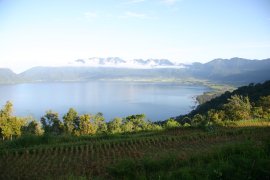 Lake Maninjau is another lake inside a volcanic crater. Significantly smaller than Lake Toba, this actually gives the effect more of dropping down inside a volcano when you drive up to it, and the final approach to the edge of the lake and the town of Maninjau itself is a very twisty road winding its way down through a series of 44 numbered hairpin bends. The views are quite marvellous, even if the weather was still pretty miserable. I parked the car and walked through the town and along the side of the lake for a while taking in the views, but once again it started raining so I spent a fair while sheltered in a coffee shop with a book. I spent the night in a small guesthouse on the edge of the lake and in the morning all was clear and bright and the views were stunning. Still, though, I had a long way to go so had a spot of breakfast taking in the views then climbed back up the crater rim bending round the 44 hairpins and back to the Highway to take me onwards, south and east.
Lake Maninjau is another lake inside a volcanic crater. Significantly smaller than Lake Toba, this actually gives the effect more of dropping down inside a volcano when you drive up to it, and the final approach to the edge of the lake and the town of Maninjau itself is a very twisty road winding its way down through a series of 44 numbered hairpin bends. The views are quite marvellous, even if the weather was still pretty miserable. I parked the car and walked through the town and along the side of the lake for a while taking in the views, but once again it started raining so I spent a fair while sheltered in a coffee shop with a book. I spent the night in a small guesthouse on the edge of the lake and in the morning all was clear and bright and the views were stunning. Still, though, I had a long way to go so had a spot of breakfast taking in the views then climbed back up the crater rim bending round the 44 hairpins and back to the Highway to take me onwards, south and east.
The next couple of days were driving, driving and more driving. The next places of interest are right on the southernmost tip of Sumatra and from Lake Maninjau it took me ten and a half hours one day and ten hours the next to get to Bandarlampung. At the intermediate night's stop I discovered that one of the two alternator belts was not where it should be but instead snapped and wrapped around the fan! Another "not good" moment and not good timing either... middle of nowhere. I did have a spare in the roof box but decided to press on with just the one belt, take things easy and hope to find a Toyota garage in Bandarlampung. I arrived and right in the middle of town, just opposite where Lonely Planet had recommended some hotels, was Toyota. I was up early in the morning to take the car across the road to be fixed, again.
To be sure, I wanted to replace the belts as a pair, and Toyota obviously agreed with me because they come in pairs. They also highlighted that the A/C belt had stretched over time and now could not be adjusted properly as the adjuster hit the end stop before the belt was properly tight... and I should be using genuine Toyota anyway... well it was Toyota Karachi that fitted it so I don't know why they sold me duff goods but anyway, I elected to change that too. A/C is important in this humidity! It all took a couple of hours as they didn't have the belts in stock but got them from another Toyota on the outskirts during which time I again acted as English teacher to the mechanics, some of whom didn't need any help from me, their English was excellent.
So that unscheduled stop complete I headed on another hour or so to Kalianda. The reason I wanted to stop there was that, apparently, it's possible to book tours out to Krakatau, the famous volcano "west of Java". Well, it's true that it's possible but you need to have a lot more money than I had, or a lot more people. The price they were asking was ridiculous enough even for a group but as a single person, and with tourism being a mere trickle these days, I'd have to charter a whole boat myself... definitely too rich for my blood. I was told I might have more success trying to arrange something from Java so I drove to the ferry port and got on the first of many ferries I'll need to take between the islands as I progress down Indonesia. The ferry took two hours of which half the time was chatting to an Indonesian guy... "Hello, where you from?"... "England!"... "Oh! England! The Beatles!"... makes a change from David Beckham at least!! He was a real Beatles fan and I don't know how many songs they recorded but it can't be many more than this chap could name. The other half of the trip I took advantage of not having to drive anywhere and fell asleep in the car. I was pretty uncomfortable and I am really dreading the longer ferry journeys - the longest will be from Flores to West Timor which takes something like 16 hours. Hopefully, like this trip, I'll be parked on an open deck in which case I'll set the tent up and have a proper sleep!
I drove to a small town on the west coast of Java called Carita which again is supposed to be the place to organise tours, but found it particularly dead. I went to a beachfront restaurant for some food and got chatting to the first western tourist I'd seen for a while - an Italian guy called Alberto. He told me that the going price for Krakatau trips from there was three times what I'd been quoted from Kalianda, so that was that definitely out of the question. He also explained that the eruption and subsequent tsunami has made the place a no-go zone for Indonesians who are scared of it happening again, despite the fact that the eruption was in 1883 and apart from that the area is a comparatively very sheltered stretch of coastline, the rest of the coastline is a lot more vulnerable as has tragically been proven in December 2004 and just a couple of months ago in May 2006. The miles and miles of upmarket resorts cater almost exclusively to the Chinese communities of Jakarta coming for the weekends and this being midweek, there were very very few people around.
Unfortunately, though Krakatau is supposedly visible from Carita the smog from the slash and burning that's been going on all over Sumatra made it impossible to even see Krakatau so I left without ever seeing it, but consoled myself with the idea of seeing much more impressive volcanoes further along through Java, Bali and Lombok.
The following day was 2nd August 2006 - exactly one year since the start of the expedition. What a lot we have seen on this trip, but to be honest it's difficult to reflect too much when one's brain is full of the present and planning the next stages. Sometimes I do take the time out to remember what I've seen and done, look at the photos etc. but if I don't have time now, no problem, I will have the rest of my life to do that when I get home!
This momentous day was marked in another way too. Entirely coincidentally, today was the day I finished listening to every track on my iPod. When I was in Iran I realised I was always listening to the same stuff so I created a "Never Played" playlist to stir up a bit of variety. It started at about 4500 tracks which had then taken me since November to listen to - a sure sign that 40GB is more music than anyone really needs. Some of it was really nostalgic but I guess I can probably delete the Megadeth now :)
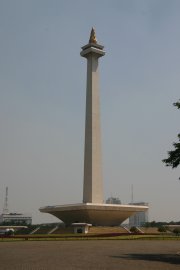 I headed into Jakarta. A big city, with 10 million population, the traffic was horrendous and the signposting worse so a couple of times I got hopelessly lost but eventually I caught sight of the National Monument - a tall tower with a gilded flame on top. Knowing that this was near where I was aiming for, I could home in and get to the Jalan Jaksa, which is the budget tourist centre of town.
I headed into Jakarta. A big city, with 10 million population, the traffic was horrendous and the signposting worse so a couple of times I got hopelessly lost but eventually I caught sight of the National Monument - a tall tower with a gilded flame on top. Knowing that this was near where I was aiming for, I could home in and get to the Jalan Jaksa, which is the budget tourist centre of town.
 Parking, surprisingly, was a doddle. I parked up and walked around some of the hostels and cheap hotels, chose one and set about the tasks for the rest of the day - internet checking shipping schedules, trying to organise a visit to a Care project and other bits and pieces, food and a quick wander around the immediate area.
Parking, surprisingly, was a doddle. I parked up and walked around some of the hostels and cheap hotels, chose one and set about the tasks for the rest of the day - internet checking shipping schedules, trying to organise a visit to a Care project and other bits and pieces, food and a quick wander around the immediate area.
 The next day was sightseeing day. I walked up to Jakarta's Merdeka (Independence) Square. Unlike the one in KL this one was not a big cricket pitch but instead a big open park with the National Monument in the middle. The tower is supposedly made entirely of Italian marble but being white it just looks like concrete. The flame on top is gilded with gold leaf but with the pollution, the sun doesn't get through enough to really make it shine. I went up to the top of the tower to get a view over the city, and what you can see is quite nice: the surrounding park, the huge nearby Istiqlal mosque and lots of buildings, some high-rise and some very low, but anything further away is obscured by the smog. Inside the large square base of the tower is the National History Museum which has its four walls lined with a series of very well-made dioramas detailing Indonesia's history and particularly concentrating on its independence struggle. Though rather one-sided in places it was very interesting.
The next day was sightseeing day. I walked up to Jakarta's Merdeka (Independence) Square. Unlike the one in KL this one was not a big cricket pitch but instead a big open park with the National Monument in the middle. The tower is supposedly made entirely of Italian marble but being white it just looks like concrete. The flame on top is gilded with gold leaf but with the pollution, the sun doesn't get through enough to really make it shine. I went up to the top of the tower to get a view over the city, and what you can see is quite nice: the surrounding park, the huge nearby Istiqlal mosque and lots of buildings, some high-rise and some very low, but anything further away is obscured by the smog. Inside the large square base of the tower is the National History Museum which has its four walls lined with a series of very well-made dioramas detailing Indonesia's history and particularly concentrating on its independence struggle. Though rather one-sided in places it was very interesting.
I then made my way to the northern part of the city centre to Kota, the old town. Though Taman Fatahilla, the large cobblestone square, has a lot of Dutch colonial character and a lot of cannons, most of the old town has crumbled away over the years leaving not much to see. There are a few museums but I wasn't in a museum mood. I returned to the area near my hotel and sat with a coffee and a newspaper. Indonesian cities are hard work, and I wanted to keep some energy for the next day, when I had arranged to visit another Care International's projects - improving the health of children growing up suffering malnourishment in the Jakarta suburbs...
| All content copyright � overland-underwater.com - please do not use without permission. |
| Comment from Ant |
| I guess we can make up our own jokes about Mr Titwoot... As for deleting Megadeth, I know you've got far more embarassing stuff on that ipod!!! |
| 04 Sep 2006 @ 13:43:25 |
